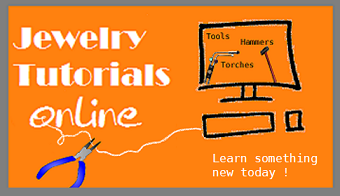Metalsmithing typically refers to the manipulation of metal sheet and wire. (whereas wirework generally refers to the use of only wire). At it’s root: ‘smithing’ refers to manipulating metal using hammers and other tools, often accompanied by the use of heat.
Our metalsmithing tutorials cover both cold and hot projects. Cold projects may use drilling, riveting, tabs, or other techniques to accomplish connections while hot projects will use a torch (not an iron) to solder and anneal the metal.
While it is agreed that the most ideal way to learn metalsmithing is in person, we have found that a good many techniques can be learned online and it is our goal to make use of modern technology to help distribute knowledge of these techniques. Most of our instructors/authors are available via email and/or online forum to answer questions, problem shoot, and critique your work.
There is a lot to learn and the tools can be never ending. It is easy to become overwhelmed. You CAN start small though .
Purchase some basic tools and add on items as you progress.
It is also important to note that you do NOT need to buy expensive ‘jewelry’ tools. You can purchase entry level tools to start and you can pick up some tools at the hardware store or on Amazon rather than at a jewelers supply house.
Below you will find a brief list of suggested metalsmithing tools.
Basic/Beginner Tools:
- Files – large (flat and halfround) and needle files
- Pliers – flat, round, chain nose
- Jewelers Saw
- Sandpaper in various grits
- benchpin
- anvil/benchblock
- Drill/flexshaft
- Assortment of drill bits
- Hammers – chasing, rawhide mallet
- handshears (scissors)
- ring clamp
- vise
- ruler
- marker (sharpie)
- scribe
- B&S Gauge
Tools needed for soldering:
- torch
- solder
- cross lock tweezers
- soldering pick
- flux
- pickle
- pickle pot
- copper tongs
- striker/lighter
- soldering surface
- quenchbowl
- tweezers
- a stop-flow
Additional tools needed for basic bezel stone setting
- Burnisher
- Bezel Roller/Rocker
- Bezel Pusher
Additional tools for the beginner:
- Ring Mandrel (to shape ring shanks/bands)
- Disc cutter (cuts perfect circles of metal from a sheet of metal)
- Bracelet Mandrel (to shape bracelets)
Safety:
- Apron
- Mask
- Eye Protection
- Ear protection
- Ventilation
- Fire Extinguisher
Disclaimer:
Safety is YOUR responsibility. Metalsmithing makes use of tools that may be heavy and sharp and therefore dangerous. Use of these tools is often accompanied by loud noise. The act of smithing and the products used can result in debris, dust, and fumes which can be detrimental to your health. It is your responsibility to make yourself aware of any risks associated with the materials and products you use and to wear personal protective gear and make use of proper ventilation however appropriate to your work. Jewelry Tutorials Online accepts no risk or responsibility for any injury you may sustain while using our tutorials.
Beginner Level Tutorials will have a supply and tools list available pre-purchase for planning. Intermediate and advanced tutorials will presume the user has basic tools and an understanding that they may need to purchase additional tools/supplies specific to the project. You may always contact the instructor with questions prior to purchase.
Metalsmithing Tutorials Page (link coming)
